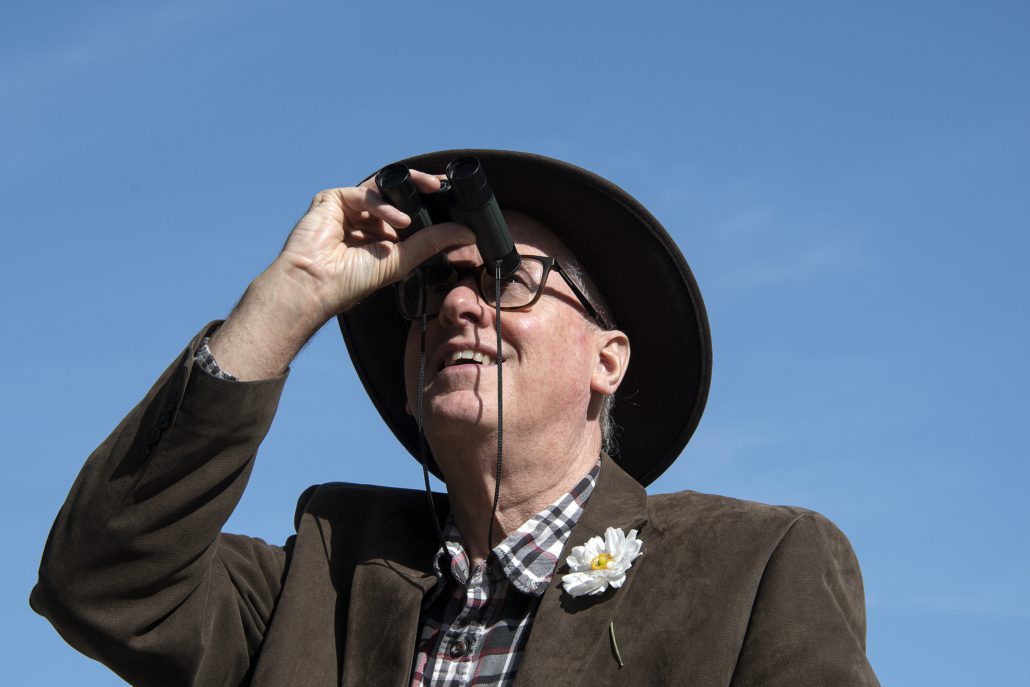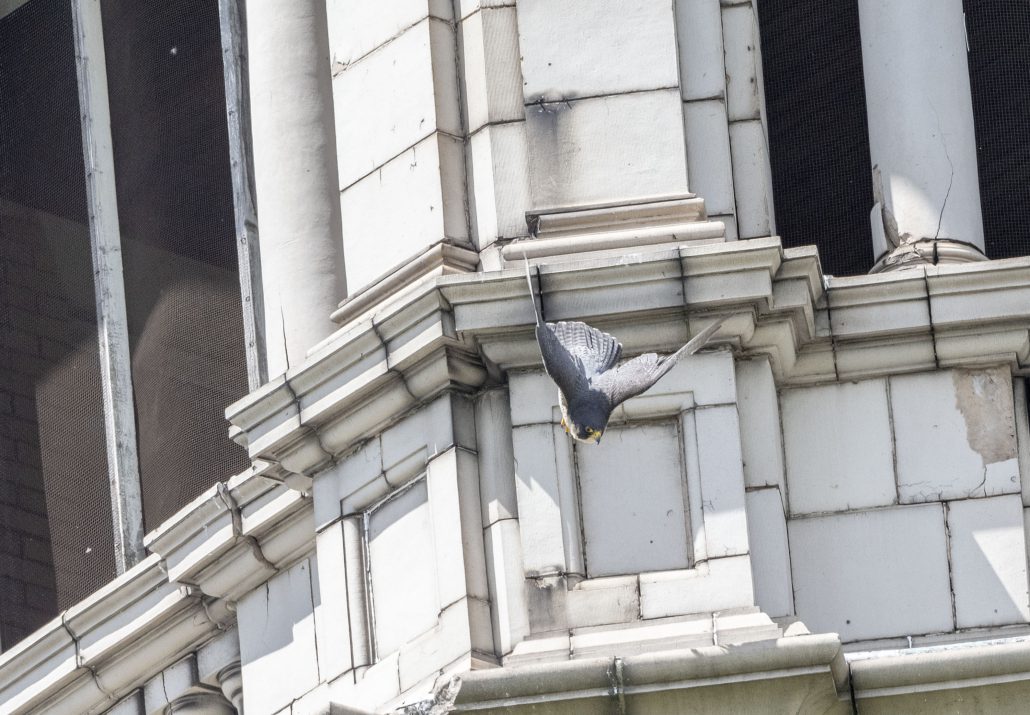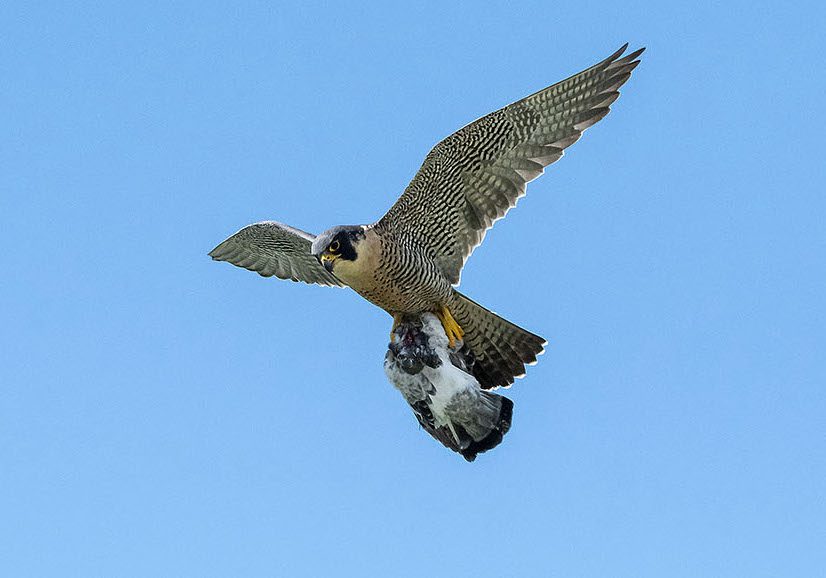Keeping Watch on the Tower, Winter 2021
By Sally Foster
“They have their schedule and they don’t always tell me,” Terry Ross quips, referring to the peregrine falcons that live at the top of the Roland Water Tower. Their unpredictable behavior is why he walks the short distance from his home on Roland Avenue to the tower three or four times a day.
Ross describes himself as a birder and he has taken it upon himself to monitor the peregrines’ behavior, not only during periods of great activity, but in the “slow” times as well. He is a widower who retired from his position as program manager for e-Learning the University of Baltimore.
“I walk up to the tower,” he explains. “I go around the tower. I wear a mask. I am able to do this and it’s something rather special.”
Looking dapper in a jaunty hat, with a Japanese anemone from his garden tucked into his lapel, Ross raises his binoculars to scour the tower for any signs of the birds. He knows their favorite perches. They seem to prefer the pilasters, which afford protection from rain and snow and offer superb visibility. Sometimes they are tucked up under the tower’s eaves, barely visible from below.
“There are times when there is a fair amount of action, particularly during the courtship phase or when they are raising their young. People read about the dramatic moments such as the bird in a dive—when it is said to be able to go more than 240 miles an hour. I have seen them go up and come down, but they don’t need to go that fast to get birds around here. Most of the time they are just hanging out…resting, nodding, cleaning themselves, conserving energy.”
According to Ross, peregrines were first noticed on the Roland Water Tower in 2015. The male is banded and is known to have been born on a lighthouse near Hart Miller Island in 2014. When he came here, nobody knows for sure. He was definitely at the tower in 2018, as was a female peregrine.
Ross explains, “Peregrines mate for life. Courtship takes place every year. The male has to reestablish himself. He has to show the female he is a good provider. He brings her food. Mating takes place on the lower edge at the belvedere. She will be there. He is up higher. She calls. For three weeks, they can’t get enough of each other.”
Ross describes the sounds peregrines make. There is the alarm noise: a loud cracking sound, “kak, kak, kak”. Young peregrines do this when they are in trouble and adults will when vultures are flying a little too low. Another call is “ee-chup”, which the birds make during courting. Sometimes there are sustained wails.
February is mating season, and eggs are typically laid in March. Ross explains that the female spends more time on the eggs than the male. For this period, she develops a brood patch that allows her skin, which is warmer than her feathers, to be in direct contact with the eggs. When she needs a break, the male takes over. Sometimes neither bird is on the eggs.
Generally, the eggs hatch in April. The usual number of hatchlings is three or four. Five is the maximum.
Ross relates a story from this spring. “The first [nestling] this year landed on the ground. It had never flown and didn’t know what flight was. Up until now, he had only hopped and flapped his wings on the tower ledge. Now he was faced with a problem: how to get back to the tower. He managed to hop up onto an airconditioning unit. Then, to make matters worse, a bluejay flew practically into his face. The baby falcon hopped and flapped and landed on the fence around the tower. The bluejay came around again, bugging him. This time, the youngster hopped and flapped and managed to fly and land on the building across the street. All this time, the parent was calling to the young and he was calling back.”
Ross continues, “Now the youngster is not being fed. The father flew over but did not feed him. The father returned to the tower and eventually the young [peregrine] managed to fly up and across the road to join him.”
“It’s not easy,” Ross muses. “Flight is a new thing. Light is a new thing. Wind is a new thing. Once out, they hop around the tower to the least windy side. It’s hard to get back inside.”
He continues, “A parent will generally feed the young on the tower. The offspring learns how to strip the feathers from the caught bird. He learns what his claws can do.”
One day, Ross watched the father teach his offspring how to grab a bird in flight. He took off with a bird carcass in his talons, the young peregrine following. The father slowed down and dropped the carcass, but the novice raptor missed it. The father swooped down and caught the carcass underneath.
“The young will be fed,” Ross says. “But the parent might make the offspring hop over to a nearby place to get the bird. The young’s next assignment will be to catch his own pigeon, mourning dove, cardinal or blue jay in mid-air. Good luck.”
“Half of the fledglings make it to their first year,” Ross adds. “They don’t have many predators around here, but they can have accidents. They can fly into buildings or they could be chased off by other peregrines.” He adds, “The young ones are kinda stupid. They can be hit by a car if they see something in the street and go after it.”
In July, there was a catastrophe. Ross got a call from a neighbor. The female peregrine was injured and on the ground in front of the tower. Phoenix Wildlife Center was called. Someone brought out a blanket and a box. Ross says, “I tried to make sure people wouldn’t get too close. She rolled over on her back and tried to right herself, but she couldn’t. It was upsetting.”
The bird died.
“The bird meant something to me,” Ross explains. “I meant nothing to the bird. The bird was a wild creature. She had never been banded. I guess it’s the wildest thing I’ve ever had a one-sided relationship with. It didn’t have a name. It wasn’t a pet or a toy. It was just a wild thing living on my block and it had been a great mother to three falcons this year.”
The restoration of the Roland Water Tower has begun and accommodations for the peregrines are part of the plan. The renovated tower will include a nesting box, which has already been approved by the Commission for Historical and Architectural Preservation. So these rare, fascinating birds will be with us for a long time.








